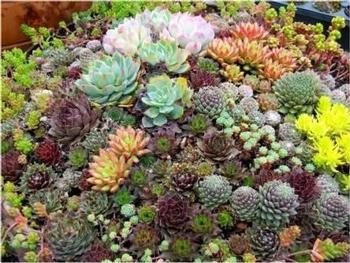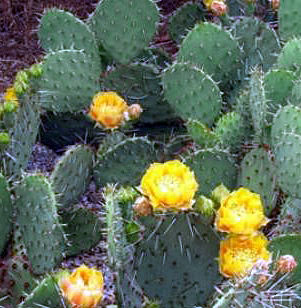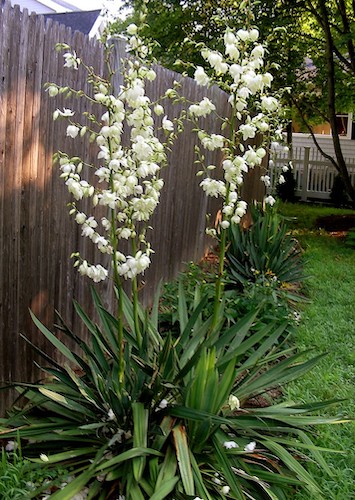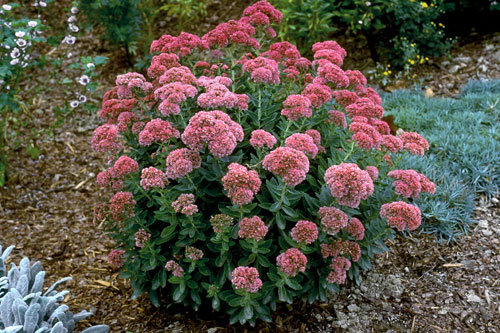Succulents Add Beauty to Your Garden
By Carolyn R. Casey, Fairfax Master Gardener Intern
 Succulents come in various shapes, sizes and textures making them beautiful and interesting additions to any garden. Some produce beautiful flowers while others contribute interesting shapes. Did you know that the word succulent means juicy? There are several succulents that like Northern Virginia’s soil and climate in Zone 7. The plants mentioned in this article are perennial and annual succulents that have done very well in my garden and have been found to be low maintenance and easy care.
Succulents come in various shapes, sizes and textures making them beautiful and interesting additions to any garden. Some produce beautiful flowers while others contribute interesting shapes. Did you know that the word succulent means juicy? There are several succulents that like Northern Virginia’s soil and climate in Zone 7. The plants mentioned in this article are perennial and annual succulents that have done very well in my garden and have been found to be low maintenance and easy care.
Succulents are drought tolerant and found throughout the world. They evolved to survive long periods of drought by storing water in swollen leaves, stems or roots. They have shallow roots that allow them to absorb water from light rains or heavy dews. Their waxy, hairy and spiny surfaces create humid micro-habitats that reduce air movement and water loss. Succulents that store water in their leaves often have thick, fleshy leaves that have a tough skin and need more water than stem succulents. Succulents also have the ability to go dormant during drought conditions.
If succulents have leaves, they may be covered with a waxy covering or white pubescence that reflects sunlight this keeps the inside of the leaf cool and reduces the need for transpiration. Transpiration is the process of water movement through a plant and its evaporation from leaves, stems and flowers. Water is necessary for these plants but only a small amount of water taken up by the roots is used for growth and metabolism. The remaining 97 to 99.5 percent is lost by transpiration.
Succulents need six to eight hours of sunlight a day. The best time to fertilize them is in the spring and summer when they are actively growing. Their most common pests are scale, mealy bugs and root mealy bugs. Succulents need to be watered in the morning to keep them from developing root rot and sunburn. Mulch and other materials that hold water need to be kept away from the base of succulents to prevent root rot and snails.
Succulents can be propagated by tip and leaf cuttings. A cutting needs a few days to heal before putting it into a root medium. Perlite, sand or vermiculite are good rooting mediums. Some succulents like sedum will become plants from a single leaf.
Types of Succulents
Hens and Chicks (Sempervivum tectorum) are perennial succulents with beautiful rosette leaves that may be green, gray, silver-violet or have a rose hue. They reproduce from offsets, tiny plants that grow near the edge of the mother plant. They are native to the mountains of southern Europe. Did you know that Hens and Chicks are cultivated in Europe not only for their appearance but as part of a Roman tradition claiming that they protect buildings against lightning strikes? They are easily grown in average, well-drained soils in full sun and tolerate some light shade. Hens and Chicks look great in rock gardens, as a border, in rock crevices, along stone walls and as a ground cover.

Prickly Pear Cactus
The Prickly Pear cactus (Opuntia) is a perennial that is native to Mexico and appears on the Mexican flag. It produces an abundance of beautiful yellow flowers that can be 3 to 4 inches wide and edible fruits called tunas that taste like watermelon. The Aztecs used the juice from the prickly pear to treat burns and drank it to treat hepatitis. Currently, prickly pear cacti are used to treat toothaches, kidney stones, burns and urinary tract inflammation. They can be eaten in salads or stews and are rich in vitamins and calcium. The juice from the fruit is used in jellies and candy. Prickly Pear cacti prefer full sunlight and well-drained soil. Plant them 6 feet apart, because they can grow 3 feet high and 6 feet wide. They should not be overwatered because that can promote root rot. Wear gloves when you handle them because the needles are sharp and difficult to remove from your hand. They do not need to be fertilized when planted outdoors, and they shrink during the winter months.

Yucca filamentosa

Delosperma cooperi

Portulaca grandiflora
Sedums
One of my favorite perennial succulents is Sedum. Sedum ternatum, also known as three-leaved snow crop, produces showy white blooms from April to May. It likes full sun to part shade and is low maintenance. It can be used as a ground cover and grows 3 to 6 inches high, spreading by creeping stems that root at the nodes. These stems break away and die in winter, leaving newly rooted plants separated from the mother plant. It also tolerates rabbits and drought.

Sedum ‘Autumn Joy’
I hope that you enjoy these beautiful succulents in your garden as much as I do in mine! Happy Gardening!
Resources
• Plant of the Week: Succulents, Gerald Klingaman, University of Arkansas Division of Agriculture,
Research and Extension
• Sedum ternatum, Missouri Botanical Garden
• Prickly Pear Cactus, Shelley McNeal, University of Maryland Extension
• Hens and Chicks, Sempervivum tectorum, North Carolina State University, Extension Gardener
Plant Toolbox
• Prickly Pear Cactus, UIC Heritage Garden
• Yucca filamentosa, North Carolina State University, Extension Gardener Plant Toolbox
• Transpiration, Wikipedia
• Portulaca grandiflora, North Carolina State University, Extension Gardener Plant Toolbox
• Hesperaloe parviflora, North Carolina State University, Extension Gardener Plant Toolbox